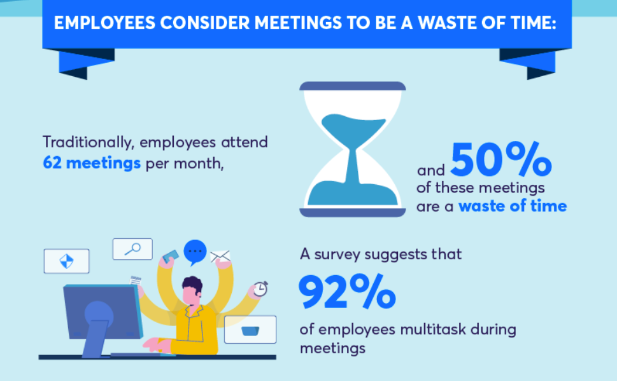We’ve all had that feeling when a meeting request lands in your inbox, and all you can do is groan. The fact is, most meetings are badly managed, poorly structured, and a waste of time. That’s especially the case if the person running the meeting doesn’t have a clear idea of why they’re calling people there in the first place. Unfortunately, effective office meetings are hard to come by.
Considering that over 50% of meetings are looked upon as a “waste of time” by employees, your business needs to shift the culture to make every meeting minute as productive as possible. In some cases, this could be as simple as reducing the total number of meetings in a week.
Yet, in order to run effective office meetings, there are a number of strategies that you can employ. In this article, we’ll turn to some of the most powerful strategies and tips to help you run more effective office meetings. Let’s dive right in.
Strategies To Run an Effective Office Meeting
Running effective office meetings doesn’t have to be particularly complicated. Most of the time, frustration around meetings comes from a lack of clear purpose and structure. By focusing on these areas, you’ll be able to refine your meetings and clearly demonstrate why they’re necessary.
Here are some of the leading strategies for running an effective office meeting:
Use Meeting Agendas
Meeting agendas are a powerful way of allowing everyone in the meeting to know exactly why they’re there. Include aspects like what you’re going to discuss in the meeting and what you expect to achieve. A meeting agenda will ensure that people engage with your meeting as they understand why you’ve called it – you don’t want your meetings to come off as a spontaneous occurrence!
Cap Meetings at 15 Minutes
The general rule is that meetings shouldn’t be more than 30 minutes. However, 30 minutes is a disruptive amount of time. Before and after the meeting, it’s likely that your employees will spend time waiting for the meeting to start or procrastinating tasks as they know they have a meeting soon. 15 minutes is a much better amount of time as it ensures that you’re in and out as quickly as possible. This time limit also makes hosts trim the fat off their meetings, sticking to only the vital topics. For the vast majority of meetings, shorter is always better.
End Meetings with Action
At the end of your meetings, you should always take time to draw up exactly what the next steps will be. Don’t let your meeting end without having established action items for everyone in attendance. You should assign tasks to people, transforming your meeting into a springboard of productivity. Meetings that use action items will help to create forward motion and ensure every minute spent is one that will lead to more productive work.
In order to run an effective office meeting, you need to focus on what the value you’re delivering will be. Whether you’re sharing new information, brainstorming, or laying out a new campaign plan, make sure you’re hitting those action beats.
If you can’t work out what value your meeting will bring, cancel it.
How to Improve Office Meeting Participation
If you suffer from a lack of conversation in meetings, there is an easy solution. You should take the time to reassess who is in the meeting. If you’re inviting a whole team to a conversation that really only concerns two people, you’re wasting time for a lot of individuals. Most of the time, if people aren’t speaking in meetings, they may just not have anything relevant to say. If that’s the case, they shouldn’t be in the meeting in the first place.
By refining the list of people you invite to a meeting, you’ll be able to keep the conversation flowing as everyone will have something to add. Don’t waste employee time by inviting them to something that they don’t need to be in. Trust us, everyone will thank you.
Using Feedback To Improve Your Office Meetings
Collecting feedback on meetings is a great way of allowing employees to express their feelings while also ensuring that meeting quality remains high. After a meeting, you can send around a quick 1-2 minute survey that asks questions about the meeting. For example, you can ask if you felt like the meeting was necessary, if employees enjoyed the meeting, and if the host was prepared.
Primarily, this allows employees to give feedback to the host and the company as a whole. Over time, this can help people improve their meeting strategy and build more effective office meetings. However, this data is also useful when getting an insight into who is good at running meetings and who could use some work.
If one of your managers continuously gets bad meeting feedback and ratings from employees, then you should talk to them about their strategies. If they need extra help, you can even give them educational resources that help them to improve how they give meetings. Equally, you can question why they call so many meetings, shifting their perspective and helping to alleviate some of that employee frustration.
When using feedback to improve your office meetings, it is vital that you keep responses anonymous. If people know HR will see who is making certain comments, they’ll be much less likely to be honest.
Final Thoughts
Effective office meetings are not unachievable. While we’re currently moving through a frustrating period of bad meetings and pointless ‘catch-up chats’, your business can overcome these habits and build a better meeting culture.
Over time, by incorporating the strategies in this article, you’ll be able to radically improve the average quality of your meetings. While this won’t be an overnight shift, any movement in the right direction will help to increase employee satisfaction and streamline your meetings. After a few months of refinement, you’ll find that your effective meetings have become a leading tool in your company’s arsenal.


